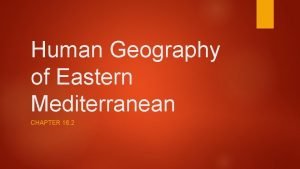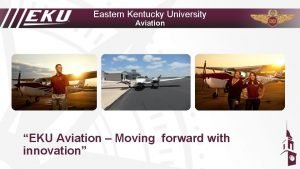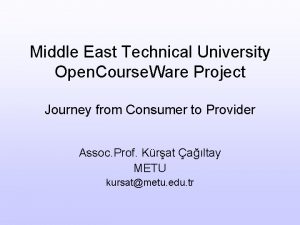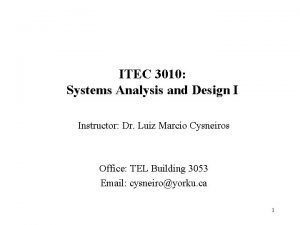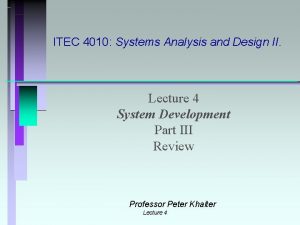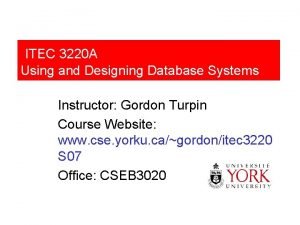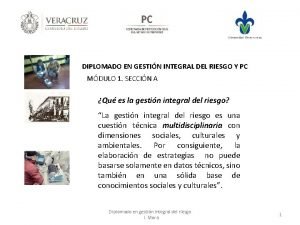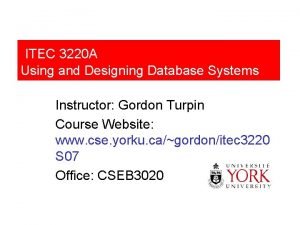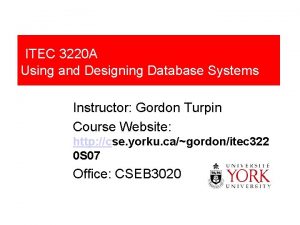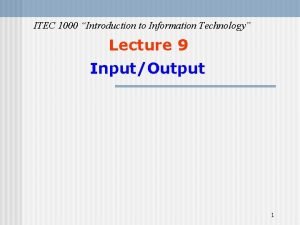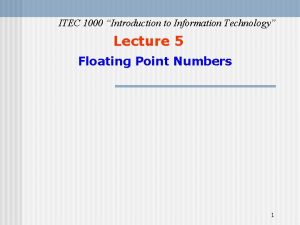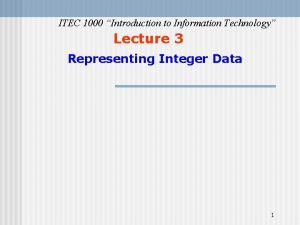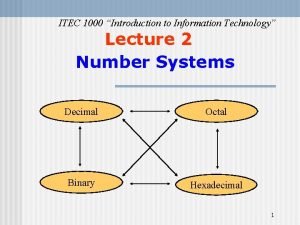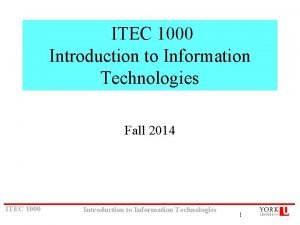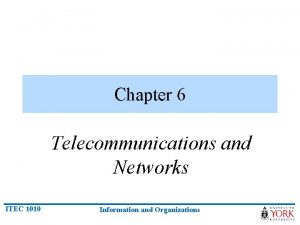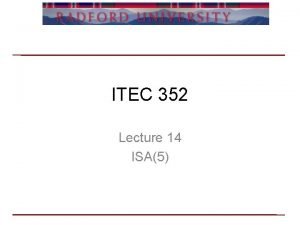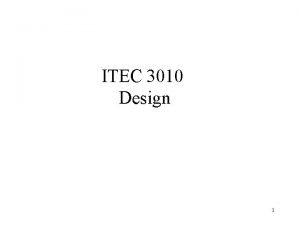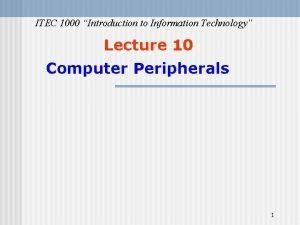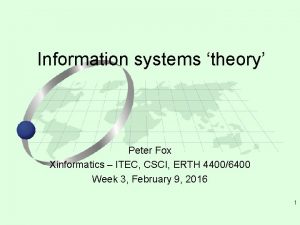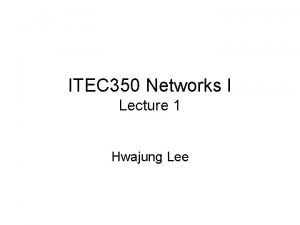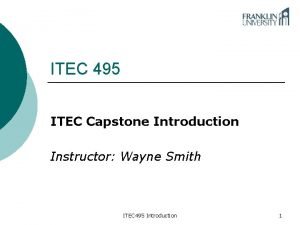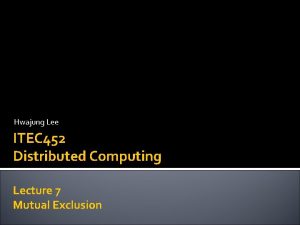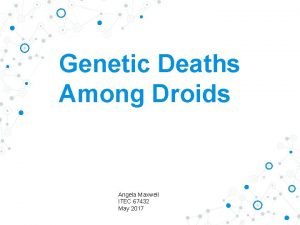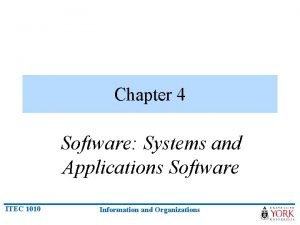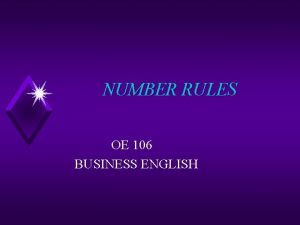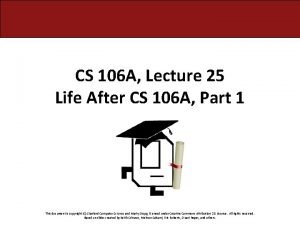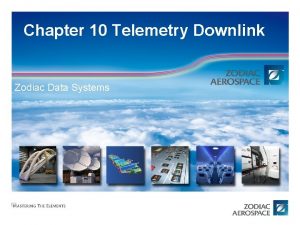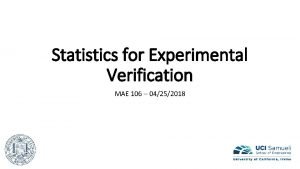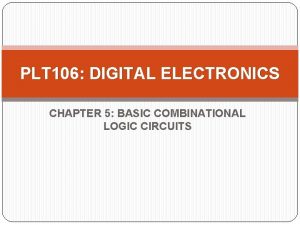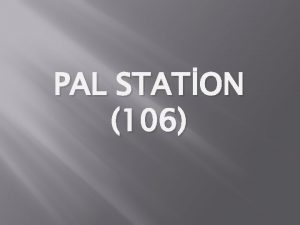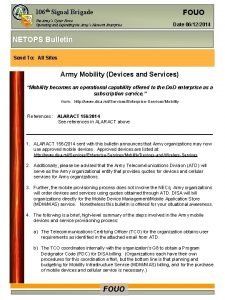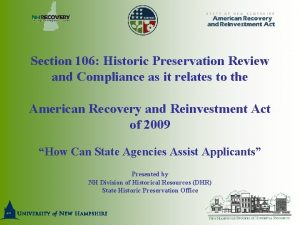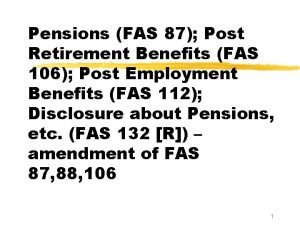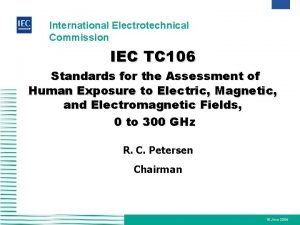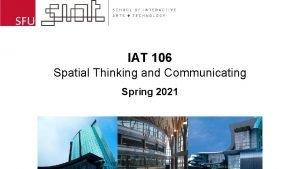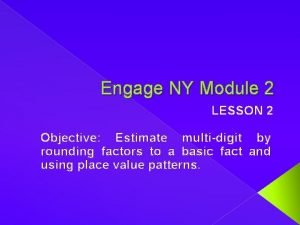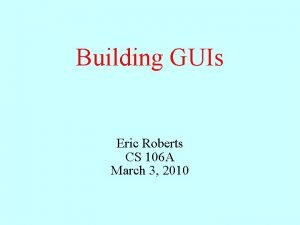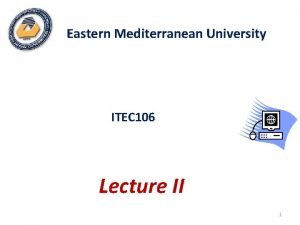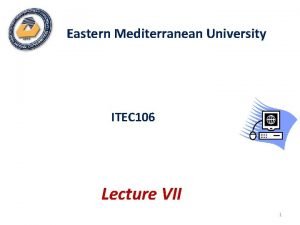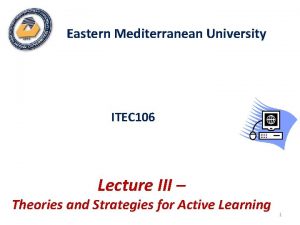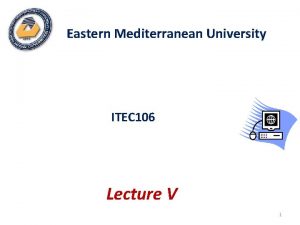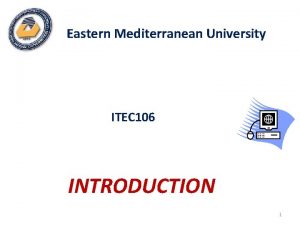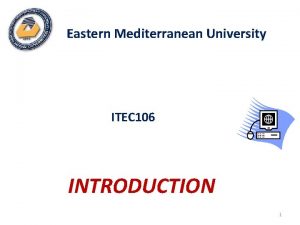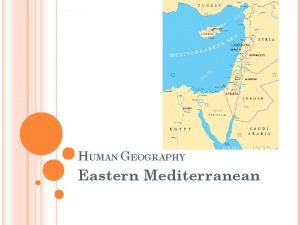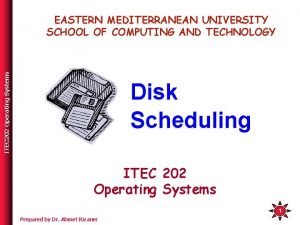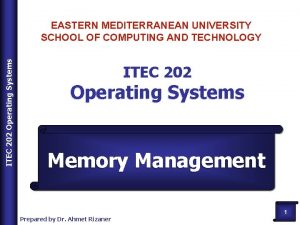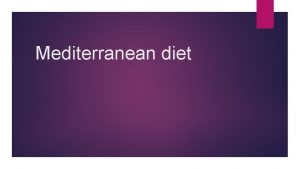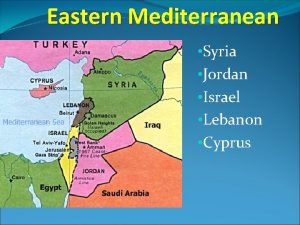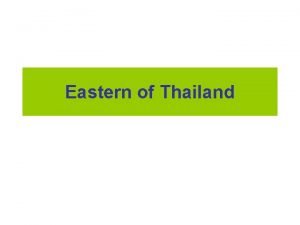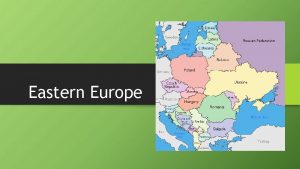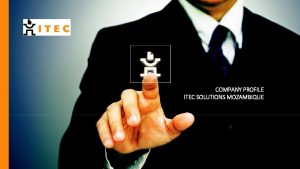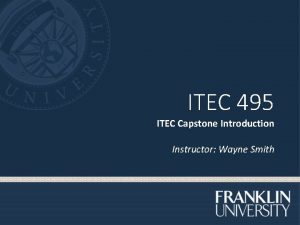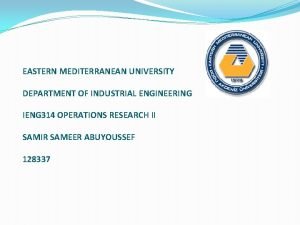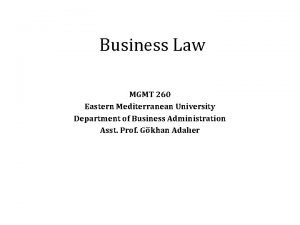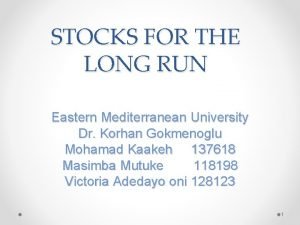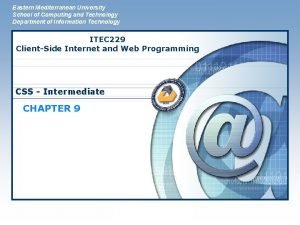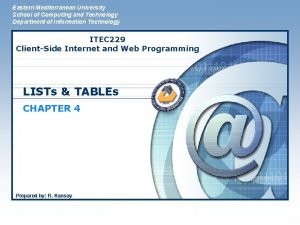Eastern Mediterranean University ITEC 106 Lecture IV Internet















































- Slides: 47

Eastern Mediterranean University ITEC 106 Lecture IV – Internet Technologies for Teaching and Learning : An Overview 1

OVERVIEW • The Internet has two main features that can support a wide range of learning activities in the classroom: – Information resources – Communication technologies • The Internet supports both synchronous and asynchronous communication channels. • Synchronous communication requires all communicating parties to be present when communication occurs, whereas asynchronous communication does not. 2

A BRIEF HISTORY OF THE INTERNET • The Internet is a global network of networks through which computers communicate. • It is an infrastructure consisting of computers, cables, wires, and other telecommunications devices plus the protocols to allow these computers to easily communicate with each other. • The Internet was developed in the 1970 s as a U. S. Department of Defense network called the ARPAnet. 3

A BRIEF HISTORY OF THE INTERNET… • The Internet today uses the ARPAnet structure and is a collection of computer networks linked through different media, connecting many campus networks, commercial networks, and government networks across the world. • By the end of 1989 the original Department of Defense ARPAnet had been retired and turned over to the National Science Foundation to form what is now called the Internet. 4

A BRIEF HISTORY OF THE INTERNET… • Thereafter, the Internet linked universities around North America and then connected to research facilities in Europe. • Use of the Internet exploded during the 1990 s, when it was expanded to allow private companies and individuals to connect to it. • Today the Internet is a loosely structured network of computers that cross geographical, political, educational, and cultural boundaries. 5

AN OVERVIEW OF INTERNET TECHNOLOGIES • Although we use the term Internet to refer to a single entity or structure, the Internet is actually the infrastructure that provides access to or exchanges of information using several telecommunication services, or technologies, across numerous networks. • In contrast to the Internet, an intranet is a private network that resides within an organization and is not accessible to the public. • It uses networking hardware and software for communicating and storing or sharing files within the intranet. • Usually a networked computer can access both an intranet and the Internet. 6

AN OVERVIEW OF INTERNET TECHNOLOGIES… • Internet technologies provide access to information that would have been impossible to access just a few years ago. • Using the World Wide Web, students have access to virtual libraries, electronic databases, and powerful search engines. • The Internet also permits interaction and communication among peers and with experts outside the local classroom, both synchronously and asynchronously. • Internet technologies support interaction and collaboration that allow students to share ideas, ask questions, and discuss classroom projects. 7

Old Internet Technologies • Old Internet technologies were used on the Internet prior to the beginning of the World Wide Web and now are not widely used. • Gopher – Gopher brought hierarchically organized text files from servers all over the world to a user’s computer. – Gopher was developed at the University of Minnesota (where sports teams are called the Golden Gophers) and was prominently used from about 1992 through 1996, when it was effectively replaced by the World Wide Web. 8

Telnet • Telnet is a protocol that permits basic communication between two host computers. • It was developed in the early days of the Internet as an accommodation to overcome simple differences among computers, such as what kind of character set to use. • Telnet allowed a person to log on to a host computer through the Internet as a regular user with whatever privileges were granted to the specific application and data on that computer. 9

Recycled Internet Technologies • Recycled Internet technologies were used on the Internet prior to the beginning of the World Wide Web but were modified to work as a Web service or are still widely used. 10

Bulletin Board Services • Bulletin board services (BBSs) are electronic message centers that host specific interest groups. • A BBS may provide archives of files, personal electronic mail, and any other services or activities of interest to the bulletin board’s system operator. • Bulletin boards are a particularly good place to find free or inexpensive software products. • Messages on BBSs are typically categorized by topics, and any user can submit or read any message. 11

Electronic Mail • E-mail was one of the original Internet technologies, yet it remains probably the most popular technology used on the Internet. • E-mail allows messages comprised of text and other media to be sent between computers. • It was invented during the 1960 s, when computer scientists devised ways of exchanging short messages within a large time-sharing computer system. • By 1970 electronic message traffic was moving smoothly on the Department of Defense network, and by the early 1980 s network mail was called e-mail and the @ sign became an indispensable component of e-mail addresses. 12

Electronic Mail… • An e-mail account is identified by an e-mail address, which has two parts, separated by an @ symbol. • To the left of the @ symbol is the account or user name; the part on the right identifies the domain of the mail server where your account resides. • The account or user name can be chosen or assigned, but it must be unique within the domain in which it is used. The Structure of an E-Mail Address 13

File Transfer Protocol • File transfer protocol (FTP) is a standard Internet protocol that permits the exchange of files between computers on the Internet. • Like Telnet, FTP was developed in the early days of the Internet (it was released as a standard protocol in 1972) to make it possible to share files between computers. • FTP is now commonly used to transfer Web page files from the Web page author’s computer to a Web server. FTP is also commonly used to download programs and other files from a Web server to a user or client computer. 14

Listservs or Discussion Lists • Discussion lists (or listservs, discussion forums, electronic mailing lists, or just mailing lists) are automated mail lists— basically, e-mail distributed to a large group. • A listserv, or mailing list manager, is a program that receives messages and automatically sends them out to the e-mail addresses of a group of users who have subscribed to the list. • Thus, list subscribers can communicate with other list subscribers without having to send individual e-mails to everyone on the list. • Each subscriber can post a message to the e-mail address of the mailing list, which serves as an alias for all list subscribers’ 15 addresses.

Listservs or Discussion Lists… • Discussion lists can be structured in several ways: – – – Moderated Unmoderated Open Closed One-way or broadcast Two -way 16

Newsgroups • Newsgroups began as a means of communication between mainframe computers at large universities. • Newsgroups use a network service called Usenet. • Usenet permits any member to participate in a public dialogue with everyone else in the newsgroup. • As it grew to become international in scope, it became probably the largest decentralized information resource in existence until the advent of the World Wide Web. 17

Newsgroups… • Usenet newsgroups are distributed among thousands of computers called news servers, which are operated by Internet service providers, universities, companies, and other organizations. • Each server receives copies of all messages in a newsgroup and stores them in a database. • News servers automatically exchange, or propagate, these messages among themselves, to keep each other’s databases up to date. 18

Newsgroups… • Newsgroups are different from discussion lists in several ways. • Postings to a newsgroup are made to a central location rather than to e-mail accounts, and Usenet articles remain on a server, whereas discussion list messages come to an e-mail account. • Further, discussion lists need only an e-mail program to view the discussion; newsgroups need a news reader or Web browser. 19

Newsgroup Discussion Categories 20

Transmission Control Protocol/Internet Protocol • TCP/IP (transmission control protocol/Internet protocol) is the basic communication language, or protocol, of the Internet. • It can also be used in a local area network. The collection of networks eventually called the Internet was named for the first word of Internet protocol. • The Internet can best be described as one large worldwide network connecting many smaller networks. 21

Transmission Control Protocol/Internet Protocol… • It is a packet-switching network. Packets are like little envelopes of information packaged and routed according to network availability. • Each packet has a destination address and is transported from one place to another until it is delivered to the correct address. • A packet may go through a series of networks before it reaches its final destination; the protocols that make the packet transformation possible are called transmission control protocol and Internet protocol, or TCP/IP. 22

Transmission Control Protocol/Internet Protocol… • TCP/IP is a two-layer program. • TCP manages the assembling of a message or file into smaller packets that are transmitted over the Internet and are then reassembled into the original message. • The other layer, IP, handles the address part of each packet so that it gets to the right destination. • A Gateway computer checks the address to see where to forward the message. 23

Transmission Control Protocol/Internet Protocol… • TCP/IP uses a client/server model of communication, in which a computer user (i. e. , a client) requests and is provided a service, such as receiving a Web page, by another computer (i. e. , a server) in the network. • TCP/IP communication is primarily point to point, meaning each communication is from one point, or host computer, in the network to another point, or host computer. 24

New Internet Technologies • New Internet technologies support the use of the World Wide Web. • Chat – Chat is real-time communication between two or more people using computers, usually through the Internet. – Any online, real-time conversation is chat or a form of chat. – Most networks, online services, and conferencing programs offer a chat feature. 25

Chat. . . • A chat room is a virtual space where a chat session takes place. • Technically, a chat room is a communications channel, but the term room supports the chat metaphor. • Because chat is intended for two-way communication, it supports a high level of interactivity among users. 26

Chat. . . • Chat can be used effectively to support Webenhanced learning in the classroom. Some of the benefits include the following: – Chat sessions are a good way to access experts in a field of study. – Teachers can provide online office hours as a chat session, allowing more than one person to benefit from the discussion. – Most chat tools keep a record or a log of conversations. – Chat sessions can be relatively spontaneous. 27

Hypertext Transfer Protocol • Hypertext transfer protocol (HTTP) is the underlying protocol used by the World Wide Web. • HTTP defines how messages are formatted and transmitted and what actions Web servers and Web browsers should take in response to various commands. • For example, when you enter a URL in your browser, you send an HTTP command to the Web server directing it to fetch and transmit the requested Web page. 28

Hypertext Transfer Protocol. . . • FTP is a two-way system in which files can be transferred back and forth between server and client computers. • HTTP is a one-way system in which files are transferred from the Web server into the Web browser of the client computer. • When HTTP appears in a URL, it means that the user is connecting to a Web server and files are transferred but not downloaded and stored. 29

Hypertext Markup Language • Hypertext markup language (HTML) is the language in which Web pages are written. • HTML uses a simple system for denoting instructions, called tags, to convey the content and structure of a hypertext document, or Web page. • Hypertext, Web pages now commonly include other media, and it may be more accurate to use the term hypermedia instead of hypertext. 30

Hypertext Markup Language. . . • HTML files, or Web pages, use HTTP to transfer Web pages from a Web server through the World Wide Web to a client computer, where they are parsed and displayed using a Web browser program. 31

Instant Messaging • Instant messaging is a form of chat that provides a more personal or private interaction between chatters but requires specialized software to be downloaded to a user’s computer. • There are several different instant messaging systems available, including ICQ, AOL Instant Messenger, Yahoo! Messenger, and MSN Messenger. • With instant messaging you create buddy or contact lists of other users with whom you wish to correspond, all of whom must be using the same instant messaging program. 32

Instant Messaging. . . • Because of the lack of an instant messaging standard, instant messaging may not be a good choice for Web -enhanced learning in the classroom. – It is difficult for a teacher to provide instant messaging support to students without installing multiple programs. • Instant messaging has a number of advantages over online chat rooms. 33

Internet 2 • Internet 2 is a consortium of over 200 universities working in partnership with industry and government to develop and deploy advanced applications for learning and research. • The Internet 2 project is not a single, separate network but joins its members together through many advanced campus, regional, and national networks. 34

Internet 2. . . • Internet 2 is itself a collection of communication and information-sharing technologies. – For example, a major function of Internet 2 is adding sufficient network infrastructure to support real-time multimedia and high-bandwidth interconnections and thus to enable applications such as telemedicine, digital libraries, and virtual laboratories that are not possible with the technology underlying today’s Internet. • Internet 2 is not intended to be a future replacement for the Internet. 35

Message Boards • Message boards, bulletin boards or forums, or threaded discussions usually refer to a Webbased asynchronous communication tool that allows you to post a message for people to read at their own convenience. • Message boards work similarly to newsgroups but function differently from discussion lists. • With discussion or mailing lists, messages are received in subscribers’ e-mail inboxes because messages are pushed from the Web server to the client computer. 36

Uniform Resource Locator • A uniform resource locator (URL) is the address or location on the World Wide Web of a document or file that resides on a Web server connected to the Internet. • The URL is the most fundamental innovation of the Web, it is the specification used by any program, computer, or server connected to the Internet to locate a resource on the Web. The Structure of a URL 37

Videoconferencing Technologies • Webcasting is a term taken from World Wide Web and broadcast. • Sometimes called Netcasting, Webcasting refers to the realtime transmission of encoded video under the control of a server to multiple recipients who all receive the same content at the same time. • Webcasting is used to deliver live or delayed versions of sound or video broadcasts. • It also refers to the delayed or preview versions of movies, music videos, or regular radio and television broadcasts, which promote the live broadcasts. 38

Videoconferencing Technologies. . . • Webcasting uses so-called push technology, in which a Web server seemingly pushes information to the user, in contrast to pull technology, in which the user seeks and downloads information, as with a Web browser. • In reality, the pushing of information is triggered by a user or a network administrator who preselects the service, it arrives only as the result of client requests. • An Internet whiteboard is an Internet application that allows users to draw objects that can then be transmitted to other users who are simultaneously using the same application. 39

Videoconferencing Technologies. . . • This electronic concept is similar to that of a real-world whiteboard: One participant draws objects that others can see, and the other participants can then add to or delete these drawings. – An electronic whiteboard allows communicating parties to share textual and graphic information in real time. • Internet videoconferencing is becoming a widely used technology. Its applications and services are usually based on technologies that allow real-time video and audio to be sent and received through computer networks. 40

Videoconferencing Technologies. . . • The advantage of these technologies over older videoconferencing is that they allow videoconferencing to occur over the Internet rather than only through phone lines. • In both cases you need a video camera and a digitizing card to transmit video signals. • A microphone, speakers (or headset), and an audio card are required for audio transmission. 41

Web Log • A Web log, or blog, is an online journal in the form of a Web page that is comprised of links and postings in reverse chronological order. • The activity of updating a blog is called blogging, and the person who maintains a blog is a blogger. • The totality of Web logs on the World Wide Web is often called the blogosphere. • Web logs are not actually an Internet technology but use Web publishing technologies and tools to disseminate information on the Web. • Two features common to Web logs are blogrolls and commenting, or feedback. 42

Web Log. . . • A blogroll is a list of other Web logs that are linked to a Web log entry or article. • Blogrolls are one way a blogger creates a context for a blog by listing other blogs that are similar. • Blogrolls can be used as a measure of blog authority, ranking blogs according to the number of references found in other blogs—much like Google rankings of search results. • Many Web logs are syndicated on the Web by distributing their headlines along with hyperlinks and summaries through a technology called Really Simple Syndication (RSS). • An RSS feed simply repackages the content of an entry in a Web log as a list of data items, such as the date of the posting, a summary of the article, and a link to it. 43

World Wide Web • The World Wide Web (WWW, or just Web) is the second most popular Internet application, second only to e-mail. • The Web is an application built on top of the Internet and used to access information resources through the Internet, using specific protocols to identify and locate that information. • The World Wide Web is a body of software, protocols, and conventions that provide for the viewing and publication of text and multimedia documents stored on computers known as Web servers. 44

SYNCHRONOUS AND ASYNCHRONOUS MODES • The Internet supports both synchronous and asynchronous communication channels. • Asynchronous communication is communication that occurs without regard to time or location; it is not necessary for all communicating parties to be present when communication occurs. • With asynchronous communication a message is sent but is not necessarily received (accessed and read) immediately. • Synchronous communication is communication that occurs in real time and is highly interactive; all communicating parties are simultaneously present. • With synchronous communication a message is sent and immediately received. 45

NETIQUETTE • Because of the unstructured nature of asynchronous and synchronous communication, it is important to establish clear rules and expectations for Internet communication sessions. • You should establish ground rules ahead of time that focus discussions on learning goals and make it easier to evaluate student participation. • Rules and expectations for information exchanges should be made clear in general guidelines for online communication. • Netiquette means network etiquette and refers to the dos and don’ts of online communication. 46

Classification of Internet Technologies 47
 Chapter 16 eastern mediterranean answers
Chapter 16 eastern mediterranean answers 01:640:244 lecture notes - lecture 15: plat, idah, farad
01:640:244 lecture notes - lecture 15: plat, idah, farad Eastern kentucky university aviation
Eastern kentucky university aviation University of eastern colorado firewatch
University of eastern colorado firewatch Ocw metu
Ocw metu Projet itec
Projet itec Ad systems exam slide
Ad systems exam slide Itec 4010
Itec 4010 Itec 3220
Itec 3220 Gestin itec
Gestin itec Itec 3220
Itec 3220 Itec 3220
Itec 3220 Itec 1000
Itec 1000 Itec 1000
Itec 1000 Itec 1000
Itec 1000 Itec 1000
Itec 1000 Itec 1000
Itec 1000 Itec 1010
Itec 1010 Itec exam results
Itec exam results First cut design class diagram
First cut design class diagram Itec 1000
Itec 1000 Itec irrigation controller
Itec irrigation controller Itec 350
Itec 350 Itec
Itec Itec
Itec Cs itec
Cs itec Bectra
Bectra Edmodo founders
Edmodo founders Gestin itec
Gestin itec Itec software
Itec software 106 spelled out
106 spelled out Fahrenheit 451 pg 45-65
Fahrenheit 451 pg 45-65 Keith schwarz stanford
Keith schwarz stanford Irig 106 chapter 10
Irig 106 chapter 10 Mae 106 uci
Mae 106 uci Plt 106
Plt 106 106 pal
106 pal 106 signal brigade
106 signal brigade N 106
N 106 Section 106 compliance
Section 106 compliance Salmo 106
Salmo 106 What is fas 106
What is fas 106 Kj 106
Kj 106 Iec tc 106
Iec tc 106 Iat 106
Iat 106 Round the factors and estimate the products exit ticket
Round the factors and estimate the products exit ticket Roberts building 106
Roberts building 106 3 108 x 7 942
3 108 x 7 942
